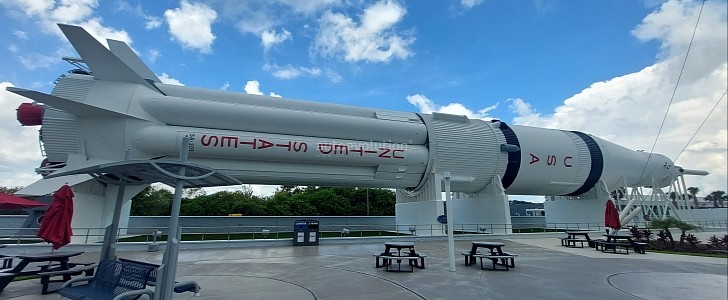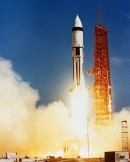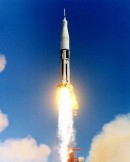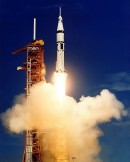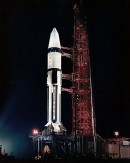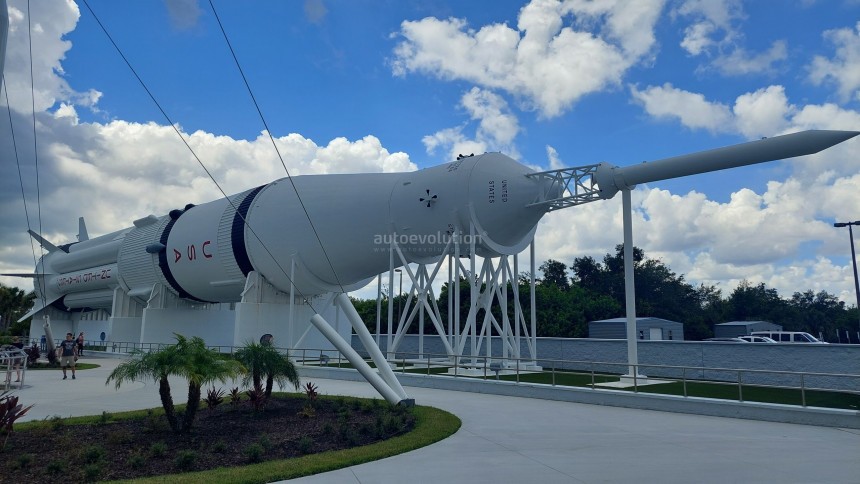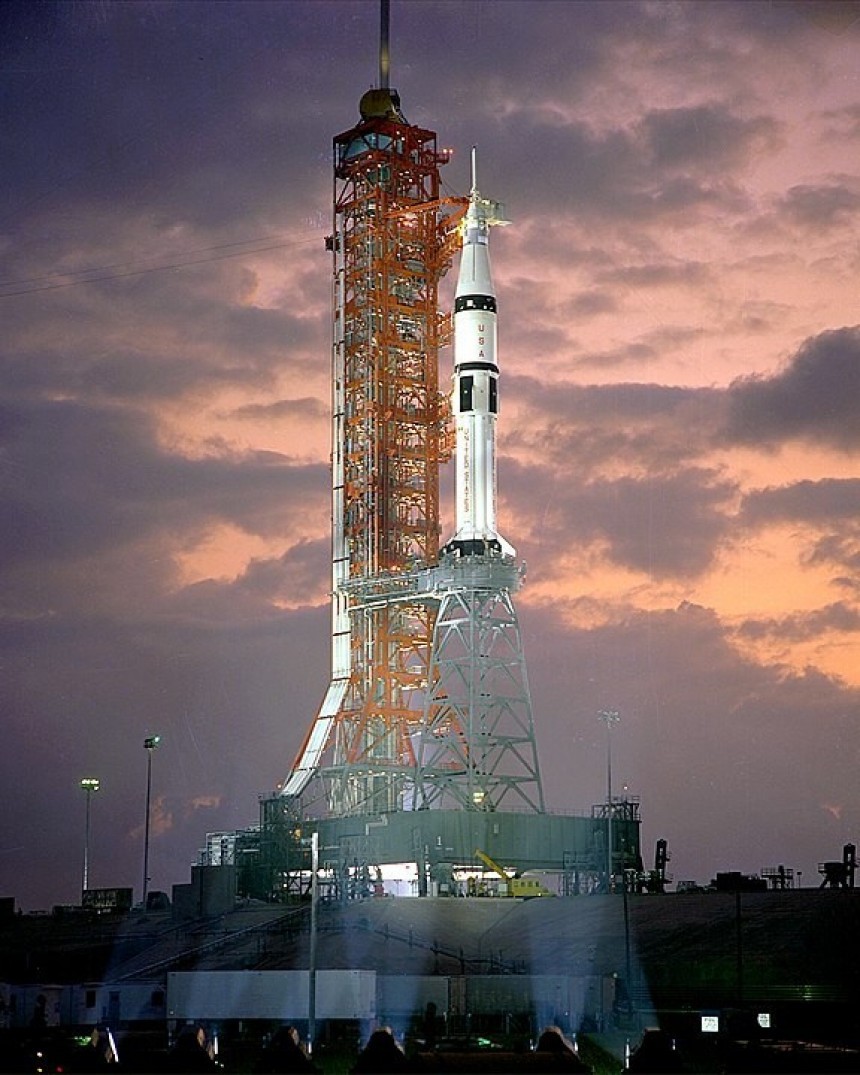Everybody sings the praises of the Saturn V booster rocket that helped bring American boots onto the surface of the Moon, and rightfully so. But so often lost in translation in telling the story of the Apollo program is there were other rockets in the mighty Saturn moon rocket family. Maybe not quite so massive, but just as vital.
The Saturn IB's story is defined by being perpetually in the shadow of its colossal, unworldly-powerful big cousin. But as we'll find, there would be no Saturn V, no Apollo moon rocket, heck, probably not an Apollo program if not for the middle child of the Saturn rocket family. Let's take a detailed look back at this criminally underrated booster rocket.
If not for the considerable genius of the ex-German rocket architect named Wernher Von Braun and his entourage of German scientists, there would most certainly not have been an Apollo either. However, his somewhat flexible moral compass was brought into question later in his life and put a dampener on his achievements. But regardless, Von Braun's exploits were vital to the success of the American spaceflight initiative formulated by NASA.
In the beginning, American booster rockets were little more than converted intercontinental ballistic missiles. Be it the Mercury-Redstone, Mercury-Atlas, the Titan series, Atlas-Agena, the Thor-Delta, or the Juno series. All had their start, not as a vehicle of exploration but as the very polar opposite. It was a Juno-1 class booster rocket modified from a Jupiter series ICBM that carried the first American artificial satellite, Explorer 1, into Low Earth Orbit. Its first stage came from a PGM-11 Redstone, just to double down on the re-used missile tech.
In many respects, the Jupiter-class booster, or more specifically, the Jupiter-C variant, was a precursor of what was to come. A large, multi-stage booster rocket powered by engines derived from the famous American Rocketdyne company. The same people who'd one day design the F-1-class engines that'd fly on the Saturn V. All the more reason why Wernher Von Braun himself referred to the type as "an infant Saturn."
Commencing with the start of the 1960s, NASA personnel at the Marshall Space Flight Center began taking the best pieces of the Jupiter program, up-scaling them by human-rated standards, and integrating them slowly into an all-new design that would become the Saturn I, the first in a new breed of purpose-built human-rated rockets in 1961.
A fine flying machine in its own right, the Saturn I was a technological test bed more than it was a fully-fledged payload delivery system. With a maximum payload capacity of 20,000 lbs (9,072 kg) to bring into low-Earth orbit, the Saturn I launched a few Pegasus micrometeorite analysis satellites and even boilerplate mockups of the Apollo Command and Service Module into space in its Block 2 configuration. Doing so over ten missions before being replaced by something altogether better.
The Saturn IB was an entirely different animal than the Saturn I. Now classified as a heavy-lift booster vehicle instead of a medium-lift like its predecessor, the IB's eight first-stage Rocketdyne H-1s had the goods to get the job done. All to the tune of 1,600,000 lbs (7,100 kN) of thrust at sea level. Fun fact, the IB's first stage was assembled by Chrysler. So then, it's a Mopar. How wonderful is that?
Its second stage consisted of a single Rocketdyne J-2. Not as visually impressive as the first stage by any means. But the J-2 set the gold standard for very high altitude secondary stage rocket engines with 200,000 lbs of thrust on offer (890 kN) in a vacuum. Even by modern standards, that's mighty impressive. Meanwhile, the vastly complex instrument control unit that acted as the nerve center for the rocket's sub-systems was a marvel in its own right.
The unit was a product of IBM, of course. As if any other computer company on the planet at that time was even in the picture. In an upgraded form, the very same system would control the Saturn V from just before liftoff until its battery was depleted. Overall, nine flights of the Saturn IB were made from and around the Kennedy Space Center in Central Florida. Five of which departed from what was then the Cape Kennedy Air Force Station from 1966 until 1968, today operated by the Space Force.
During the Apollo-Soyuz and Skylab Space Station missions between 1973 and 75, the rocket used the iconic Launch Pad 39B. Doing so while attached to a comical-looking device called a milk stool platform to align the pad's umbilical links with the smaller Saturn IB.
Today, the only place you can see a fully assembled Saturn IB is inside the remarkable Rocket Garden exhibit at the Kennedy Space Center's Visitor Complex. A short bus ride away from where a very different rocket currently sits, waiting to launch the Artemis I mission around the Moon on the very same pad the IB used to launch from.
Stay tuned for more from our trip to Cape Canaveral and the Kennedy Space Center for the Artemis I mission right here on autoevolution.
If not for the considerable genius of the ex-German rocket architect named Wernher Von Braun and his entourage of German scientists, there would most certainly not have been an Apollo either. However, his somewhat flexible moral compass was brought into question later in his life and put a dampener on his achievements. But regardless, Von Braun's exploits were vital to the success of the American spaceflight initiative formulated by NASA.
In the beginning, American booster rockets were little more than converted intercontinental ballistic missiles. Be it the Mercury-Redstone, Mercury-Atlas, the Titan series, Atlas-Agena, the Thor-Delta, or the Juno series. All had their start, not as a vehicle of exploration but as the very polar opposite. It was a Juno-1 class booster rocket modified from a Jupiter series ICBM that carried the first American artificial satellite, Explorer 1, into Low Earth Orbit. Its first stage came from a PGM-11 Redstone, just to double down on the re-used missile tech.
In many respects, the Jupiter-class booster, or more specifically, the Jupiter-C variant, was a precursor of what was to come. A large, multi-stage booster rocket powered by engines derived from the famous American Rocketdyne company. The same people who'd one day design the F-1-class engines that'd fly on the Saturn V. All the more reason why Wernher Von Braun himself referred to the type as "an infant Saturn."
A fine flying machine in its own right, the Saturn I was a technological test bed more than it was a fully-fledged payload delivery system. With a maximum payload capacity of 20,000 lbs (9,072 kg) to bring into low-Earth orbit, the Saturn I launched a few Pegasus micrometeorite analysis satellites and even boilerplate mockups of the Apollo Command and Service Module into space in its Block 2 configuration. Doing so over ten missions before being replaced by something altogether better.
The Saturn IB was an entirely different animal than the Saturn I. Now classified as a heavy-lift booster vehicle instead of a medium-lift like its predecessor, the IB's eight first-stage Rocketdyne H-1s had the goods to get the job done. All to the tune of 1,600,000 lbs (7,100 kN) of thrust at sea level. Fun fact, the IB's first stage was assembled by Chrysler. So then, it's a Mopar. How wonderful is that?
Its second stage consisted of a single Rocketdyne J-2. Not as visually impressive as the first stage by any means. But the J-2 set the gold standard for very high altitude secondary stage rocket engines with 200,000 lbs of thrust on offer (890 kN) in a vacuum. Even by modern standards, that's mighty impressive. Meanwhile, the vastly complex instrument control unit that acted as the nerve center for the rocket's sub-systems was a marvel in its own right.
During the Apollo-Soyuz and Skylab Space Station missions between 1973 and 75, the rocket used the iconic Launch Pad 39B. Doing so while attached to a comical-looking device called a milk stool platform to align the pad's umbilical links with the smaller Saturn IB.
Today, the only place you can see a fully assembled Saturn IB is inside the remarkable Rocket Garden exhibit at the Kennedy Space Center's Visitor Complex. A short bus ride away from where a very different rocket currently sits, waiting to launch the Artemis I mission around the Moon on the very same pad the IB used to launch from.
Stay tuned for more from our trip to Cape Canaveral and the Kennedy Space Center for the Artemis I mission right here on autoevolution.
